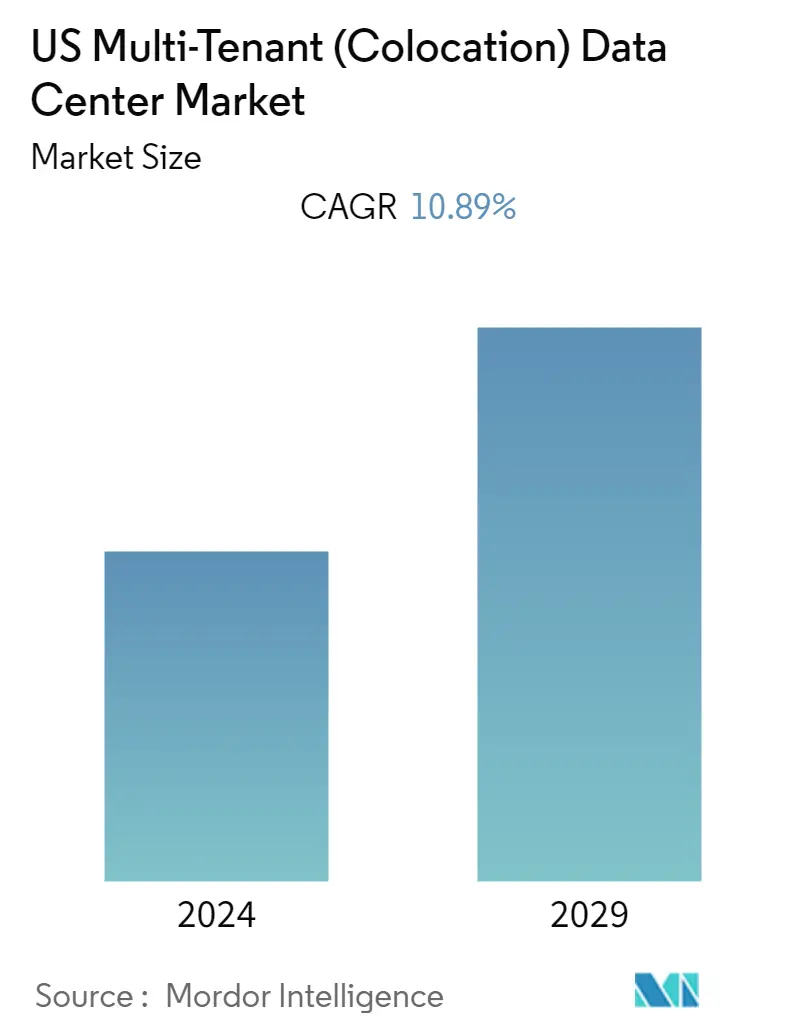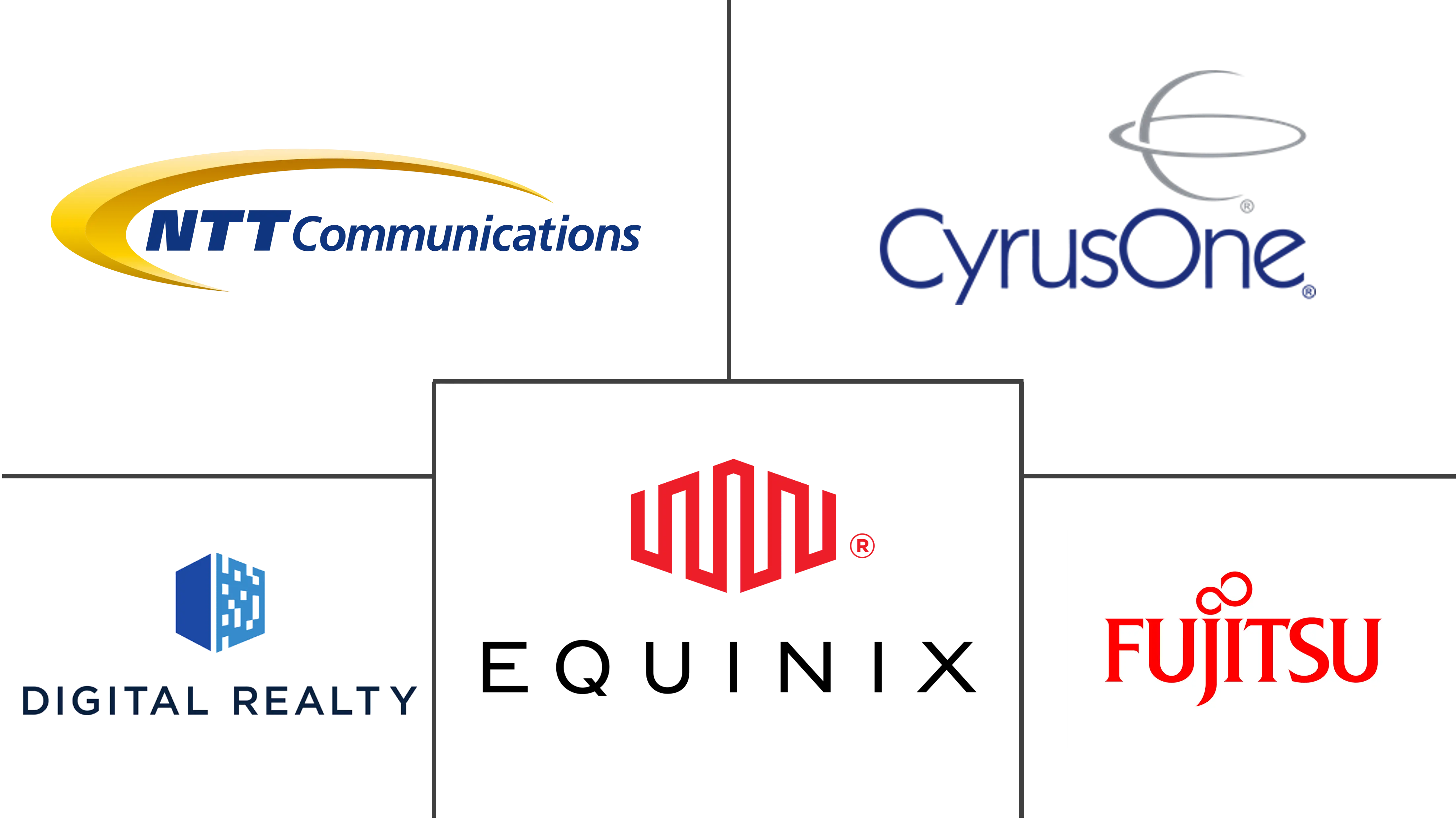Market Size of US Multi-Tenant (Colocation) Data Center Industry

| Study Period | 2019 - 2029 |
| Base Year For Estimation | 2023 |
| Forecast Data Period | 2024 - 2029 |
| Historical Data Period | 2019 - 2022 |
| CAGR (2024 - 2029) | 10.89 % |
| Market Concentration | Low |
Major Players
*Disclaimer: Major Players sorted in no particular order |
US Multi-Tenant (Colocation) Data Center Market Analysis
The US Multi-Tenant Data Center Market is expected to register a CAGR of 10.89% during the forecast period(2024-2029).
The United States multi-tenant (colocation) data center market is expected to register a CAGR of 10.89% during the forecast period.
- The United States is one of the major countries in terms of the number of data centers. The multi-tenant data center leasing activity in the United States has been increasing due to the expansion activities of some of the major hyperscale tenants operating there.
- The growing data center traffic, in parallel to the rapid technology advancements in areas such as IoT and Artificial Intelligence, among others, is leading to an increase in the data traffic in the country. According to Cisco forecasts, there will be 4.6 billion networked devices by 2023, rising from 2.7 billion in 2018. In addition, smartphones are expected to account for 7% of all networked devices by the current year.
- The rapid digitization in end-user verticals such as government, retail, healthcare, IT, and Telecom is also expanding the horizon for the multi-tenant market in the country. The government's digitization strategy is an example that the country is moving towards complete digital operations.
- However, challenges such as a heightened dependence on the regulatory landscape & stringent security requirements have adversely impacted the market in the country. The standards such as HIPAA, PCI DSS, and others prevail as standard checkpoints.
- Markets like Northern Virginia and Silicon Valley, with 5.1% and 1.6% vacancy rates, respectively, are still impacted by electricity and land constraints. Delays in the delivery of the substations are the leading cause of the challenges Northern Virginia is experiencing, not a lack of power production. Both delivery-side and generation-side electricity problems exist in Silicon Valley. This could make it difficult for new growth in a market where supply is already constrained. Both markets expect more vertical, multi-story data center buildings to compensate for the limited amount of developable land in necessary districts.
- The pandemic resulted in disruptions in construction & expansion plans for colocation service providers. In the short term, the pandemic has created uncertainty regarding construction and expansion timelines. With a direct effect on labor due to lockdowns, the allied crunch caused in the operations was also partly due to stringent guidelines of procedures.
US Multi-Tenant (Colocation) Data Center Industry Segmentation
Colocation is a data center facility under which corporations and enterprises can rent space for servers and other computing hardware. It is used in wholesale and retail colocation in industries like BFSI, manufacturing, and energy.
The United States multi-tenant (colocation) data center market is segmented by solution type (wholesale multi-tenant, retail multi-tenant), size of the organization (small and medium enterprises, large enterprises), and end-user vertical (BFSI, manufacturing, it, and telecom, healthcare & life sciences, government, entertainment, and media).
The market sizes and forecasts are provided in terms of value (USD) for all the above segments.
| By Solution type | |
| Wholesale Multi-tenant | |
| Retail Multi-tenant |
| By Size of the organization | |
| Small and Medium Enterprises | |
| Large Enterprises |
| By End-user Vertical | |
| BFSI | |
| Manufacturing | |
| IT and Telecom | |
| Healthcare & Lifesciences | |
| Government | |
| Entertainment and Media | |
| Other End-user Verticals |
US Multi-Tenant (Colocation) Data Center Market Size Summary
The United States multi-tenant (colocation) data center market is experiencing significant growth, driven by the increasing demand for cloud-based solutions and the rapid digitization across various sectors such as government, healthcare, and IT. The expansion activities of major hyperscale tenants and the growing data traffic, fueled by advancements in IoT and Artificial Intelligence, are key factors contributing to this growth. Despite challenges such as regulatory dependencies and stringent security requirements, the market is poised for substantial expansion. The pandemic has introduced some uncertainties in construction and expansion timelines, but the overall trend towards digital transformation and cloud adoption remains strong.
The market is characterized by a fragmented landscape with numerous players, including prominent companies like Digital Realty Trust, Inc., NTT Communications, and Equinix Networks. These companies are actively engaging in strategic partnerships and developments to enhance their market presence and penetration. Recent initiatives, such as Equinix's commitment to reducing power consumption and Expedient's partnership with Kyndryl to bolster cybersecurity offerings, highlight the industry's focus on sustainability and security. The acquisition of edgepresence by Ubiquity further underscores the trend towards localized and scalable network solutions, catering to the increasing demand for efficient and secure data center operations.
US Multi-Tenant (Colocation) Data Center Market Size - Table of Contents
-
1. MARKET DYNAMICS
-
1.1 Market Drivers
-
1.1.1 Growing Adoption of Cloud Services is expected to flourish the market
-
1.1.2 Increasing Growth in Wholesale Datacenter Multi-tenant Spaces to propel demand (albeit from a lower base)
-
1.1.3 Increased Emphasis on Compliance with Data Regulations and Cost-Effective Nature of Multi-tenant Facilities to Drive Adoption among SME's
-
-
1.2 Market Restraints
-
1.2.1 Dependence on Regulatory Landscape & Stringent Security Requirements
-
-
-
2. MARKET SEGMENTATION
-
2.1 By Solution type
-
2.1.1 Wholesale Multi-tenant
-
2.1.2 Retail Multi-tenant
-
-
2.2 By Size of the organization
-
2.2.1 Small and Medium Enterprises
-
2.2.2 Large Enterprises
-
-
2.3 By End-user Vertical
-
2.3.1 BFSI
-
2.3.2 Manufacturing
-
2.3.3 IT and Telecom
-
2.3.4 Healthcare & Lifesciences
-
2.3.5 Government
-
2.3.6 Entertainment and Media
-
2.3.7 Other End-user Verticals
-
-
US Multi-Tenant (Colocation) Data Center Market Size FAQs
What is the current US Multi-Tenant (Colocation) Data Center Market size?
The US Multi-Tenant (Colocation) Data Center Market is projected to register a CAGR of 10.89% during the forecast period (2024-2029)
Who are the key players in US Multi-Tenant (Colocation) Data Center Market?
Digital Reality Trust, Inc., Equinix, Inc., Fujitsu Americas Inc. , CYRUSONE and NTT Communications are the major companies operating in the US Multi-Tenant (Colocation) Data Center Market.

